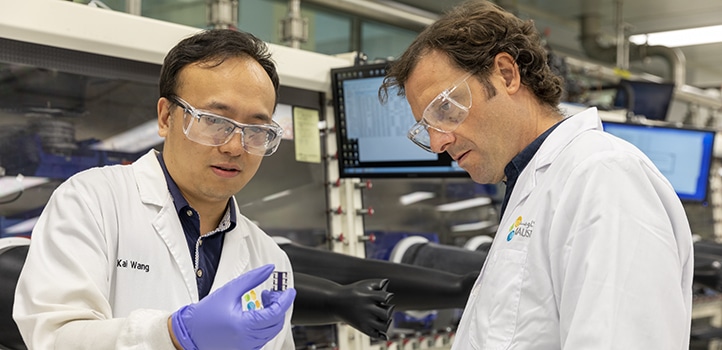Aug 27 2019
Solar cells that depend on perovskites to harness sunlight are bound to gain in energy conversion efficiency on account of an atomic-level understanding of the structure-property connection of these photovoltaic materials.
 Kai Wang (left) and Stefaan De Wolf examine their perovskite solar cell. (©2019 KAUST)
Kai Wang (left) and Stefaan De Wolf examine their perovskite solar cell. (©2019 KAUST)
Scientists from the KAUST Solar Center observed the impact of compositional variations on the structural organization and photovoltaic properties of perovskite thin films in situ.
Hybrid perovskites have materialized as main components in economical, high-efficiency solar cells because they are easier and cheaper to make than conventional silicon-based solar cell materials. Furthermore, they display unique optoelectronic features, including a defect tolerance and high light absorption that yield solar cells with the highest power-conversion efficiencies of 24% to 28% when used alone or along with silicon. Hybrid perovskites also outdo single-junction silicon solar cells.
The performance and stability of solar cells rely on the morphology of the thin films, particularly their ability to crystallize in the so-called photoactive α-phase. Perovskites comprising lead have a tendency to integrate different halides, such as the anionic forms of iodine and bromine, with mixtures of formamidinium, cesium, methylammonium, and other cations.
These have resulted in record conversion efficiencies and thermal stabilities compared with their single-halide, single-cation analogs. But, these mixed-halide, mixed-cation perovskite films have been defined only through ex-situ post-deposition methods. This confines the understanding of the mechanisms that regulate their growth from their sol-gel precursor to their solid state and stalls attempts to enhance device stability and performance.
Currently, Stefaan De Wolf, his postdoc Kai Wang and co-workers, have examined the influence of halides, cations, and anti-solvent dripping on mixed-halide, mixed-cation perovskite films. Using an in situ X-ray scattering method, the researchers monitored the films’ structural development during the spin-coating deposition process.
The X-ray method investigated the films at the atomic scale from their sol-gel precursor to the solid state and delivered data about the development of crystalline intermediates during the solidification. The scientists also integrated the films into solar cells and assessed the stability and performance of the ensuing devices.
Our study provides critical insights into the crystallization of the multicomponent systems toward high-performance perovskite solar cells.
Kai Wang, Postdoc and Researcher, KAUST Solar Center
Variations in the compositions of the halide and cation radically impacted the solidification of the perovskite precursors during spin coating and the ensuing formation of the desired α-phase upon anti-solvent addition.
The period required to produce high-quality films by anti-solvent addition ended when the sol-gel structure collapsed to create crystalline by-products based on the precursor mixture. As a result, tweaking the halide-cation mixture could delay this collapse, broadening the anti-solvent dripping window from a few seconds to several minutes.
Besides, simultaneously incorporating rubidium and cesium cations in the perovskite synergistically triggered the development of the α-phase. The length of this window showed a minimal effect on resulting solar cell performance as long as the anti-solvent was integrated within this period.
These findings propose new guidelines for the advancement of perovskite formulations that can additionally stabilize the sol-gel state and boost its conversion to the needed perovskite phase.
This is critical in achieving better-performing, reproducible, cost-efficient and scalable manufacturing of perovskite solar cells.
Kai Wang, Postdoc and Researcher, KAUST Solar Center
The team is aiming to shift this knowledge to other deposition technologies to move toward market-ready perovskite solar cells.
Tiny tweaks for big wins in solar cells
KAUST materials scientists are using an in situ X-ray scattering technique to provide critical insights into the crystallization of the multicomponent systems toward high-performance perovskite solar cells. (© 2019 KAUST)